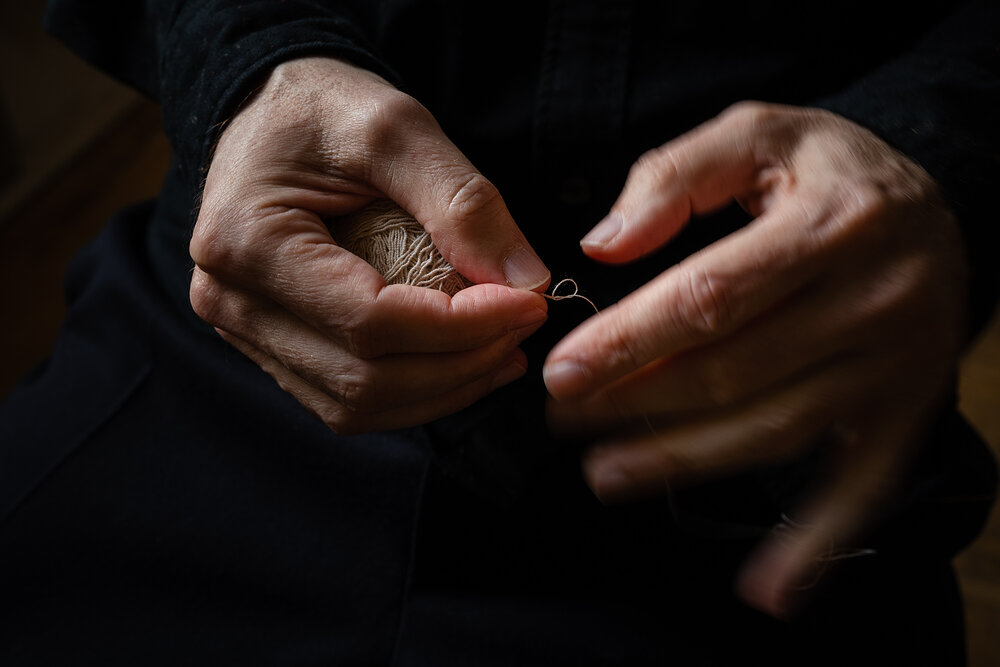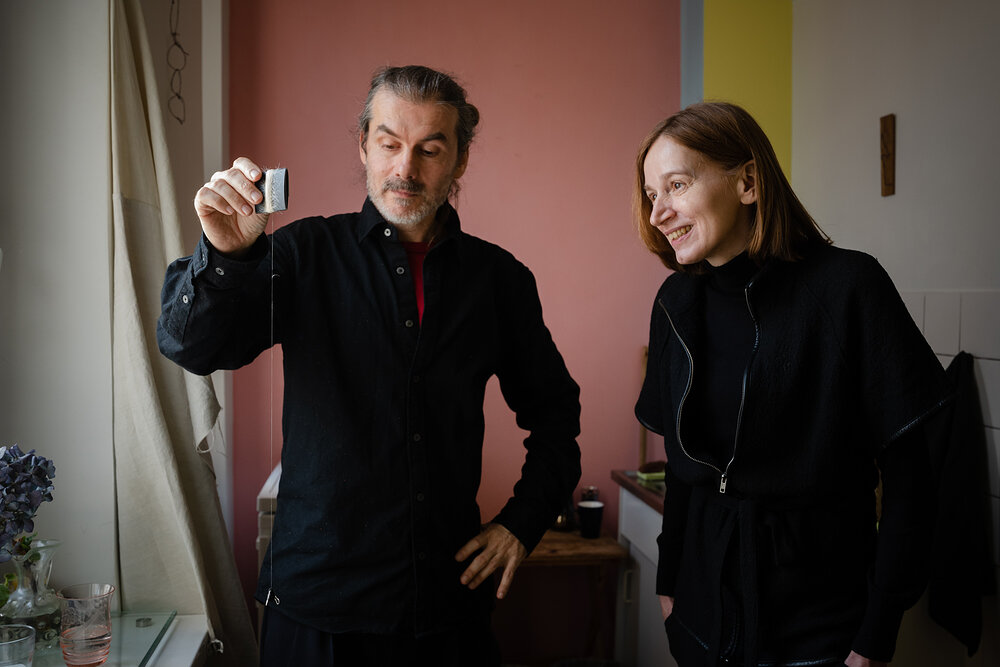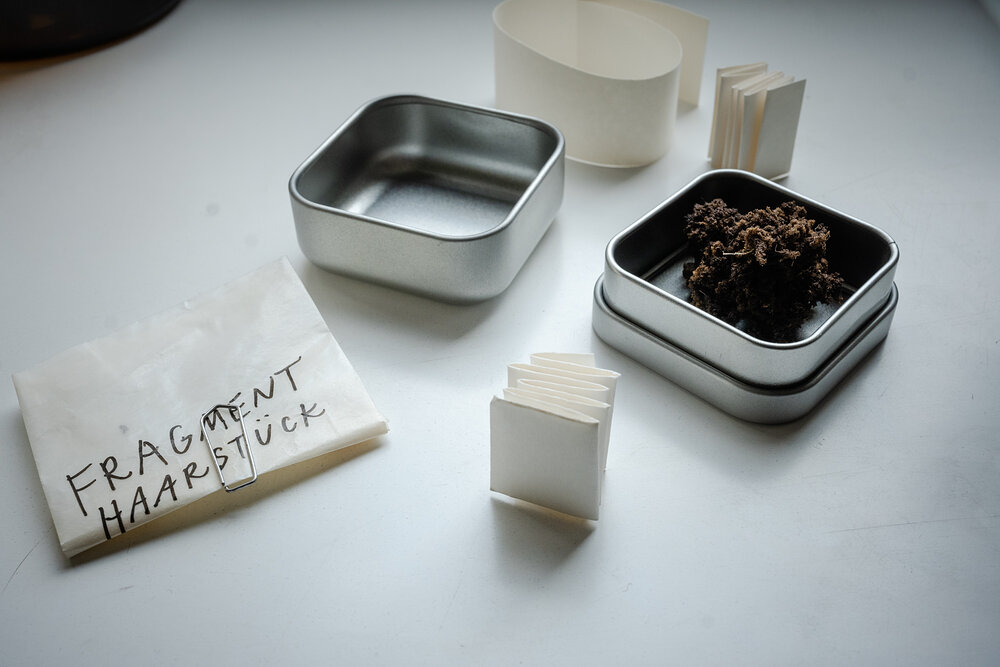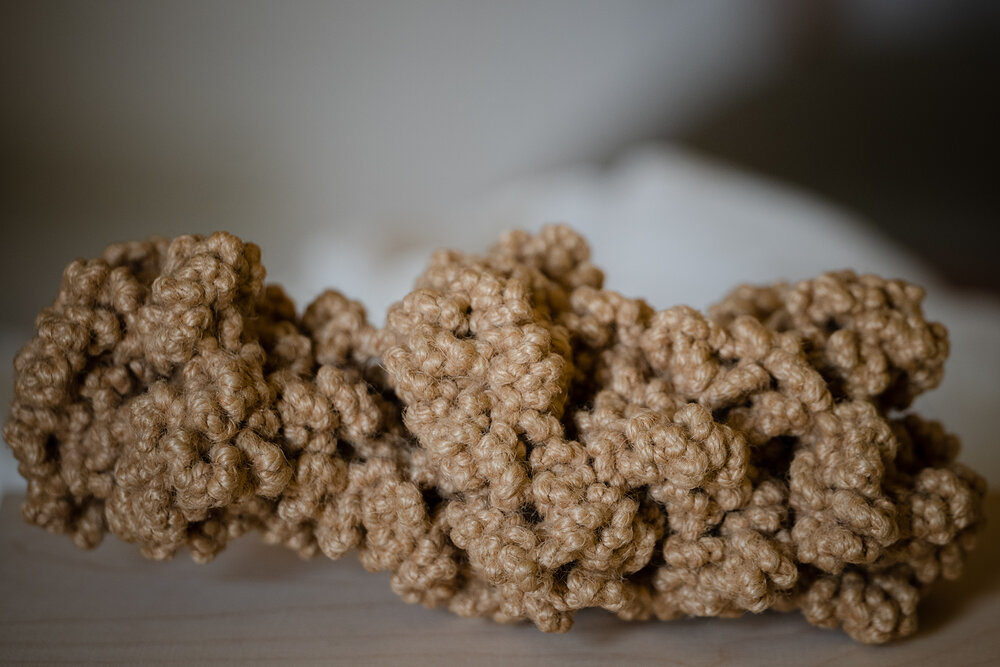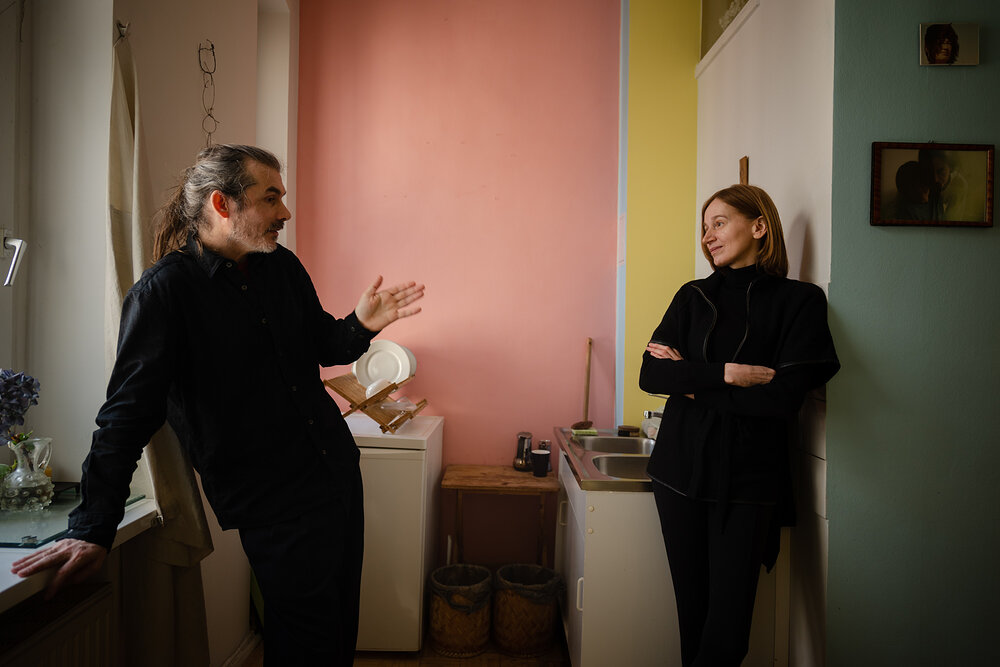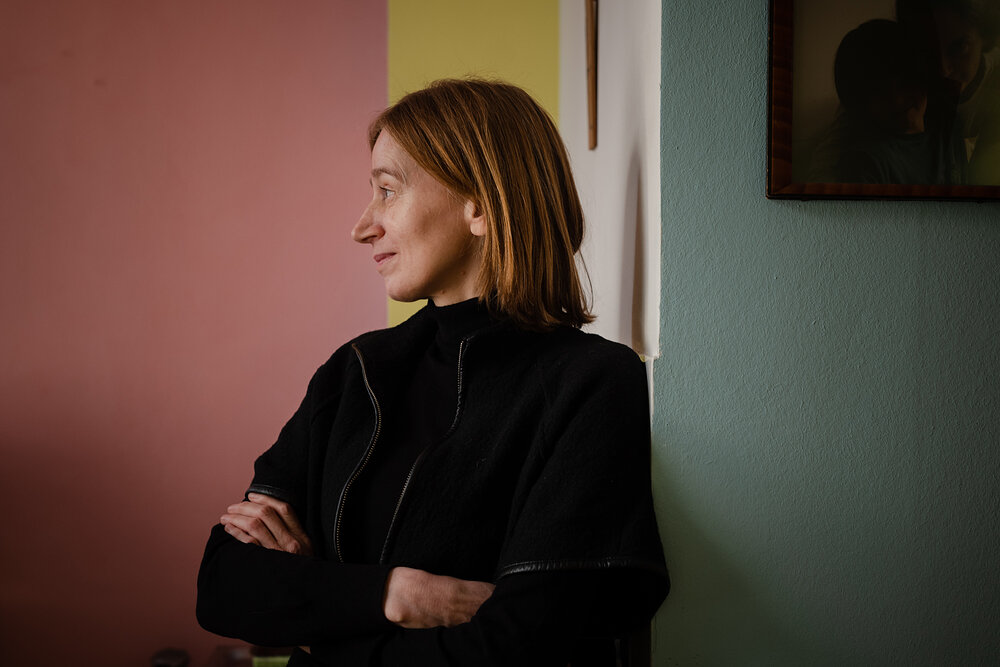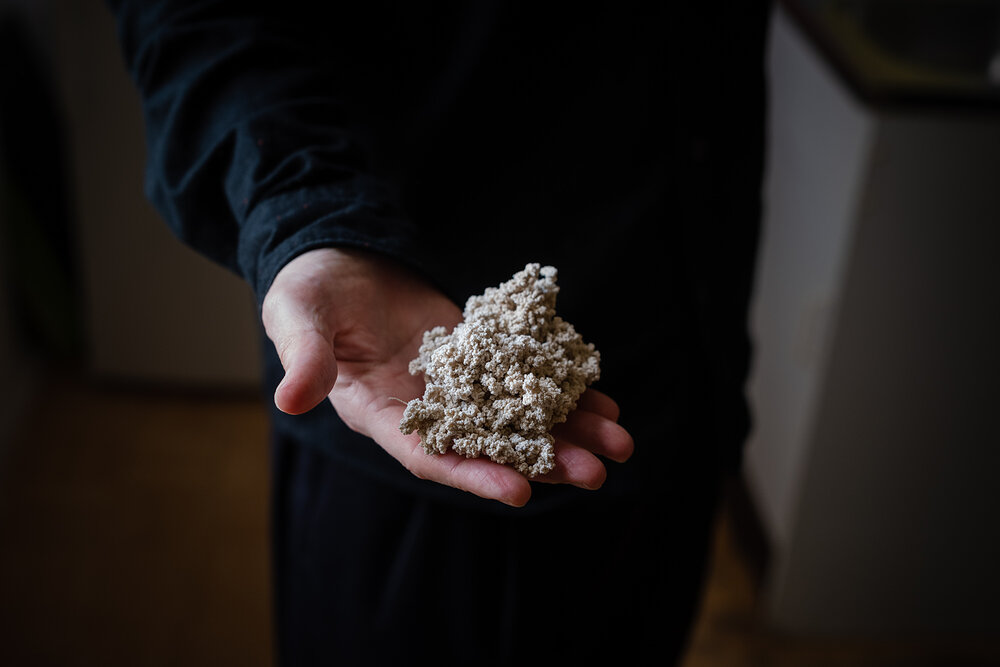Issue 18 / June 2023
Letter from Berlin
Of Untangling a Thought
September 2022
I headed to Berlin to tie and untie knots. I was armed with cords of various lengths and colors as part of my project “Shared Skills,” which tackled one of our oldest cultural technologies: our ability to create slings and knots from hair, plant and animal fibers, tree branches, blades of grass and other stalks or pliant materials. For we encounter knots throughout the world and across time, in all those places where humans seek to fasten and loosen things. Knots demarcate joints and hinges, so along with their practical application in hunting, crafts, transport and engineering they also have a magical, religious, medicinal, mathematical and aesthetic significance. Those in the field of topology have recently become interested in knots because they are spatial entities and can teach us the properties of mathematical structures.
One certainly imagines the knot to be primarily a hard and palpable thing, similar to a button or knob, but knotting a knot is in fact a fluid process. Among other things I’m interested in how a simple line, such as the one we draw with a pen on a sheet of paper by changing the direction of the stylus back and forth and by turning and twisting the wrist, can emerge vividly before our eyes as something that becomes comprehensible.
I used to draw a lot myself, first in little notebooks that I carried in my pocket, and especially when my brother gave me a thick stack of large-format drawing paper which I laid on the floor. All of a sudden, drawing was no longer just fine strokes and scribbles or twisting and turning the wrist within a confined space, but an energy-sapping act of moving the entire body and working from the elbow and shoulder joints on the shapes and crosshatches, the lines and sweeps. Sometimes I would get very angry during this work, or I simply aimed to exhaust myself, while on other days the strokes were tentative and delicate. Sometimes the curves and arcs would match the rhythm of my writing, but then they would run amok again and flit about aimlessly on the paper; sometimes they would run out over the end of the paper and onto the floor and finally stop there only because my strength was at an end. In such moments it is difficult to return to the small format and narrow space – the sheet of paper or the laptop on the table with a chair in front of it. One grows aware of that early stage when we were brought up to tame our hands and miniaturize our forms of communication.
In my room at the Villa Walther, a large drawing pad now lies next to the colorful cords. I haven’t drawn for a long time. My hand is stiff.
October 2022
The research assumes that our ability to make knots was formed in historical deep time more than 500,000 years ago. But due to the organic material employed, which was exposed to decay, there are no physical relics older than 10,000 years. Were the circumstances different, and if we weren’t merely using implicit inference to conclude that early humans tied knots, our historiography would probably be different. The use of organic materials, which have not survived, has strongly impacted our view of mankind’s early formation. For instance we would principally be weaving and braiding creatures and, so far as everyday life is concerned, we would perhaps not be speaking of a Stone Age but rather of a Basket-Weaving Age. I don’t know what that would have meant for the hierarchy of the sexes. But it also continues to mean that knots are the best evidence we have in lieu of any written description of the associated craftsmanship and other skills, and it is precisely this lack which has changed our perception of history. Material and technique are passed on differently than form. Much as dance treatises were late in coming because dance is only practiced through instructors and not instructions, craft practices will often resist contemporaneous or retrospective discursivation. Only a small fraction of our knowledge about knotting, weaving and meshing techniques has ever been written down.
Archeological findings give us at least some information. The first simple knots that have been passed on to us were the Half Hitch as well as its converse variant the Reversed Half Hitch, the Two Half Hitch, the Timber Hitch, the Half-Hitch Noose and the Overhand Noose. On a systematic level these are understood to be operations where a single twist and no more than two bends of a rope are used to obtain, more or less randomly, a series of effective tie knots and loops that remain stable when the object is removed. So I pick up my cords and practice these knot forms, knowing that they are among the earliest cultural techniques we know. They are easy to practice because they are still today in constant use. We use them to tie packages and shoelaces or just to fasten the dog leash to a post. The Ashley Book of Knots has recorded 3,900 different types of knots and each of these means a different operation, a different type of movement of the hand and an altered topology. The list that emerges is systematically organized and strikes me as a kind of mantra – Knob Knots, Clove Hitches, Butterfly Loops, Diamond Knots, Love Knots, Thief Knots, Turk’s Heads, Monkey’s Fists . . . I note at this point the extent to which there has thus far been a theory of knots that understands them as both material objects and dynamic processes of form. It is only since the late eighteenth century that there have been attempts at all to catalogue the variety of our netting arts. At about the same time, with A. T. Vandermonde and of course Carl Friedrich Gauss, the knot became a subject of mathematical investigation. In this regard a Reef Knot and a Lark’s Head Knot are considered topologically equivalent – they have the same number of interlacings and can be transformed into the other respective knot through deformation; however, in the world of handcrafts, they are two entirely different operations.
The drawing pad still lies in front of me.
November 2022
During lunch the question arises as to whether the quipus or khipus (Spanish and Quechuan, respectively, for “knot”) of the Inca Empire will also be playing a role in my project? André posed the question, not suspecting that he had thus indicated a first important Berlin starting point, namely the Ethnological Museum. It houses the world’s largest collection of khipus from the seventh to the seventeenth century. The current form of presentation, however, cannot adequately convey the actual use to which these knotted strands were put. Ittai was sitting at the same table and he summed up the problem in an aside by noting that the knots all looked oddly motiveless in the display cases, as if they were disembodied wigs or something. Au contraire. Once upon a time they were hanging, dangling, perhaps balled up in the hand and then held up with arms outspread so that the knots of the freely hanging secondary cords could be seen and felt. A khipu was used to record the number of inhabitants, animals, goods and tracts of land in a particular region as well as to transport messages and other correspondence. The knot was thus at the interface between writing and number, for with its help one could represent multi-digit numbers in the decimal system and up to 95 different syllables. But above all it served as an aide-mémoire for bookkeeping and statistics – in other words as an administrative tool. Each knot meant the presence of a thing or some certain matter, so it was important to understand just what kind of knot was tied in the strand. This makes it clear how much the handedness of our knotting movement, as well as its rhythm or the topology of the intersecting and intertwining strands, determine what form emerges from it and how it is further encoded.
I order numerous books and read up. For example, in the Inca Empire a Figure-Eight Knot stood for the digit 1 of the unit position, and so on and so forth. It means that every manipulation of matter from a manual movement can mutate to a symbolic action and furthermore to a sign system.
January 2023
By now, lots of people have heard of my interest in knotting. Fellows from evolutionary biology and behavioral research are now coming forward because in the kingdom of nature there are amazing examples of the art of knotting and entwining, as can be impressively seen in the nest-building of weaver birds. Jana had first asked me about this, since she’s interested in the linguistic ability of birds and also in the use of tools and certain techniques in the animal kingdom. So can knotting even be called a cultural technique? In the evenings, practicing knotting techniques with my colorful shoelaces, I watch videos where birds form incredibly complex abodes. They guide the stalks with their beaks as if they were poking and pulling a thread through fabric with a sewing needle. It seems that the success of their construction lies in a single formal operation that has been tested in repetition and thus crept into the evolutionary plan. Other bird species also have amazing weaving techniques. For instance the goldfinch makes use of the cobwebs of ermine moths to elastically weave and glue its nest, which consists of many fine materials, by extracting individual threads from the webs and winding them up into a ball in its beak then flying back to the nest.
Evolutionary biological and anthropological models put their argument in basically the same way. When successful, local repetition leads to a fixed repertoire of shape formation in individual groups, and it is far from certain just which techniques have been passed on between different populations and which of them have evolved independently. Basic knots such as the Half Hitch Knot or the Overhand Knot were probably discovered again and again and used because of their mechanical properties for fastening, closing or stopping something.
I inquire in the library and Stefan puts some dictionaries with annotation notes in the tray for me. Etymologically, the word “knot” refers to something that is “clenched and compressed,” also something that is small and thickened. I like the relationship between German words such as Knoten (knot), Knopf (button), Knospe (bud), Knolle (bulb), Knute (knout), Knebel (handle), Knauf (knob), Knirps (tot), and even the Knie (knee) a lot; I make a list and pronounce the words aloud. In doing so, I learn that small things – and by that I mean things which are short, thick and stout – were denoted by the sound kn: Knäuel (tangle), Knochen (bone), Knorpel (gristle), Knöchel (knuckle), Knüppel (cudgel), Knödel (dumpling) . . . This phonetic sequence indicates a material presence in a confined space and at the same time refers to a corner, a rounding and especially an articulation point where directions can be changed and new positions taken. Also revealing is the consonance of “knot” and “not” which occurs in English; that is, the essential interplay between the presence and the absence of a thing. A plotline can therefore materially entangle and thicken while also dissolve into nothingness.
Euclid spoke of a point which in its movement becomes a line, a surface, a space – and vice versa – but in such geometrical models the straight line and later the three-dimensional coordinate system dominate. Instead I am interested in processes where the line in its movement spirals and eddies; it swirls, coils and strays, crossing and touching and massaging itself into a tangle that one is extremely hard put to unravel.
February 2023
In the meantime a completely different kind of knot-theoretical disaster befalls me. The structure of my hard disk, which has grown rapidly over the years and become unstable in its complexity, is on the verge of collapse. In view of the long file paths and the widely branching data tree, this means that they are in urgent need of disentanglement and shortening. During this long process I receive a tip from Wiebke, head of the IT department, about a podcast on Berlin artist Jens Risch who has devoted his entire creative life to knots. “Nulla dies sine nodus” might be his adapted version of the maxim coined by the ancient painter Apelles, whose paintings were famous for the dexterity and delicacy of their line, achieved through tireless practice, and who said he never let a day go by without drawing a line with his brush. Jens Risch spends several hours each day using thread to draw his lines and tie his knots. Him, I definitely want to meet.

Early this morning I receive a text from Ittai. He is currently in Italy and from Trento he sends me a photograph of the knotted columns of San Vigilio Cathedral (1212-1321). This type of column was used primarily in Byzantine and Romanesque art. It spread over a wide geographical area encompassing northern Italy, Bavaria and Burgundy, and in particular it became associated with the Cistercian order.
Symbolizing the dual nature of the human and divine bodies of Christ, or of God the Father and the Son as united in the Holy Spirit, the Love Knot is an apposite sign for the conjoining of earthly and divine powers. According to Pliny the Elder it was precisely due to its unifying character that this knot possessed healing properties and could interlace binate principles such as male and female. Wounds would heal faster if a bandage was tied with this knot, and in ancient Rome it was the custom to engirdle the bride’s wedding garment with a Love Knot; untying it silently and with no assistance was part of the wedding ritual.
Nota bene: Drawing the Love Knot is a completely different experience from tying it – you simply cannot tell how it’s made.
April 2023
We have an appointment to visit the studio. Jens Risch works exclusively with Overhand Knots, which is the simplest knot there is. It is tied by winding the end of a thread around its own standing part. His silk thread is a thousand meters long. Every day for the past fourteen years, Risch has strung knot after knot by twisting his wrist, making a loop and passing the thread through the opening. Then he tightens the loose knot with his fingertips to create a small hard button. On and on like this, in constant repetition, the thread is bent and pulled with a movement of the hand that first reaches out and then turns back and screws upward before pausing and then, in the opposite direction, tightening and stopping the knot. The room is very quiet. You have to peer closely because the thread is so fine – even the knot is barely visible. And yet you can follow how a line becomes a spatial thing through a twist and a turn. At one time I can see the knot, at another the process of knotting.
After an hour, to relieve his right hand, Risch knots with his left – although the knot retains its right-handedness and continues clockwise. Approximately 360 simple knots are tied per hour, twenty knots make up one centimeter, so within an hour he produces some eighteen centimeters. Every day he knots for between two and four hours. After 1294 hours, i.e. after an average of 370 days, the thread has grown to 233 meters. Now begins the next generation of knots, as Risch calls it, and this strand is also steadily shortened with Overhand Knots. This is followed by the next row, and by the next, comparable to a potentization of the structure, a repeated multiplication of a knot with itself. The knot of a knot of a knot . . . The length of the thread shrinks from 233 meters to 58 to 12.30 to 3.35 to 0.85 meters - and finally to about 9 centimeters . . . The process accelerates toward the end because the time intervals between the generations grow shorter. Conversely, the surface area increases and the thin thread has become a complex body that reminds us of sponges or corals or a brain.
Proteins also knot together, although this seems improbable from an evolutionary point of view. Knotted proteins have greater kinetic difficulties than unknotted ones because they take longer to fold and knot into their finished structure. They were long thought to be phylogenetic holdovers, but recent studies provide evidence that knots stabilize proteins by mooring them together.
The drawing pad is still in front of me.
I’m ready to write my book on knots.
Berlin artist Jens Risch‘s response to our curiosity about his knots works was an immediate invitation to his home. The portraits accompnying this text were taken during extensive conversations there. Many thanks for having us!
More on: Karin Leonhard
Images: © Maurice Weiss
